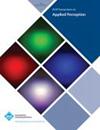虚拟现实中校准的可通行性感知转移到增强现实
IF 2.1
4区 计算机科学
Q3 COMPUTER SCIENCE, SOFTWARE ENGINEERING
引用次数: 0
摘要
随着虚拟现实(VR)和增强现实(AR)技术应用的增加,了解用户如何感知他们在虚拟环境中的行动能力将非常重要。关于动作的反馈可能有助于校准对动作机会(可供性)的感知,以便VR和AR中的动作判断反映演员的真实能力。先前的研究表明,在挥舞物体的同时穿过虚拟门口,可以通过碰撞的反馈来校准对自身通行性的感知。在目前的研究中,我们的目标是在VR中使用不同的范式通过反馈来复制这种校准,同时测试这种校准是否转移到AR。参与者在45度处举着一根杆子,并在AR(预测试阶段)中做出合格判断。然后,他们在VR中做出通过性判断,并通过拿着杆子穿过虚拟门口来接收这些判断的反馈(校准阶段)。然后,参与者返回AR进行测试后通过性判断。结果表明,反馈校准了参与者在虚拟现实中的判断。此外,这种校准转移到AR环境中。换句话说,在经历了VR中的反馈后,VR和AR中的可通过性判断变得更接近演员的实际能力,这可以使这些技术的培训应用更加有效。本文章由计算机程序翻译,如有差异,请以英文原文为准。
Calibrated passability perception in virtual reality transfers to augmented reality
As applications for virtual reality (VR) and augmented reality (AR) technology increase, it will be important to understand how users perceive their action capabilities in virtual environments. Feedback about actions may help to calibrate perception for action opportunities (affordances) so that action judgments in VR and AR mirror actors’ real abilities. Previous work indicates that walking through a virtual doorway while wielding an object can calibrate the perception of one’s passability through feedback from collisions. In the current study, we aimed to replicate this calibration through feedback using a different paradigm in VR while also testing whether this calibration transfers to AR. Participants held a pole at 45 degrees and made passability judgments in AR (pretest phase). Then, they made passability judgments in VR and received feedback on those judgments by walking through a virtual doorway while holding the pole (calibration phase). Participants then returned to AR to make posttest passability judgments. Results indicate that feedback calibrated participants’ judgments in VR. Moreover, this calibration transferred to the AR environment. In other words, after experiencing feedback in VR, passability judgments in VR and in AR became closer to an actor’s actual ability, which could make training applications in these technologies more effective.
求助全文
通过发布文献求助,成功后即可免费获取论文全文。
去求助
来源期刊

ACM Transactions on Applied Perception
工程技术-计算机:软件工程
CiteScore
3.70
自引率
0.00%
发文量
22
审稿时长
12 months
期刊介绍:
ACM Transactions on Applied Perception (TAP) aims to strengthen the synergy between computer science and psychology/perception by publishing top quality papers that help to unify research in these fields.
The journal publishes inter-disciplinary research of significant and lasting value in any topic area that spans both Computer Science and Perceptual Psychology. All papers must incorporate both perceptual and computer science components.
 求助内容:
求助内容: 应助结果提醒方式:
应助结果提醒方式:


